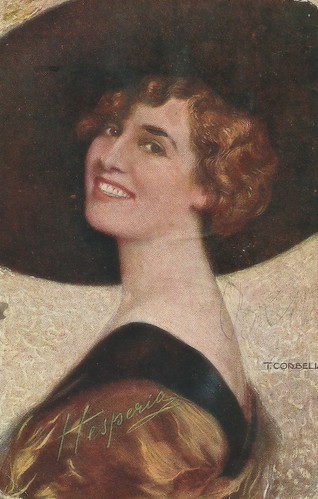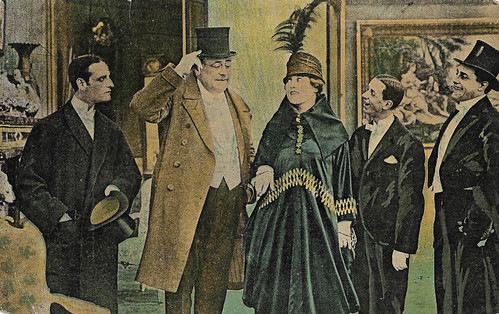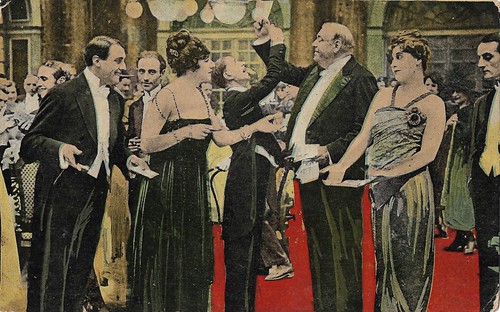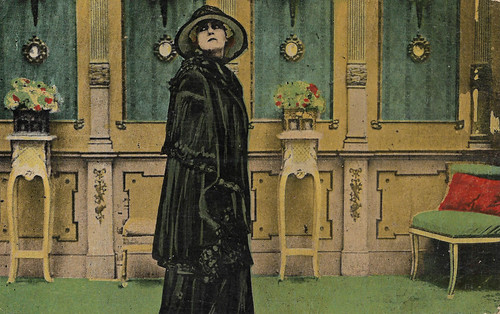
Italian postcard by Uff. Rev. Stampa, no. 229. Sent in Milano, 2-4-1917. Hesperia by Tito Corbella.
Jou-Jou (1916)
Jou-Jou (Hesperia) is adored by her husband but prefers Maurizio, married to her cousin, and passionate about horse racing.
They enjoy their moment of love in Amalfi, but once returned to France, Maurizio returns to his wife. Jou-Jou cannot take it anymore, and while taking a bath, she swallows poison.

Spanish cromo card by Chocolate Imperiale, Barcelona, no. 6 of 6 cards. photo: Dist. J. Verdaguer / Tiber-film. Hesperia in Jou-Jou (Baldassarre Negroni, 1916). The set reminds us a bit of a cloister such as the Chiostro del Paradiso in Amalfi.
Bonvivant Gaston de Neuil (Tullio Carminati) is tired of the Parisian excesses of the good life and looks for rest and fresh air at his family castle in the countryside. One night he sees a mysterious young woman passing the gate, with a sad expression. He finds out this is Claire de Beauscaut (Hesperia), a lady who for two years lives isolated at her castle of Courcelles.
Intrigued, he invents an excuse to see her, telling her he has grave news from Paris. He is immediately received, but when he asks to pardon for his fib Claire is surprised and scandalised at first. Afterwards, to relieve herself, she tells him her sad history...
The Italian press thought the basis of the film, a novella by Honoré de Balzac, too static and interiorised for the medium of film, but praised the mise-en-scene by Baldassarre Negroni, the cinematography by Renato Bini, and the actor's performances, in particular those of Hesperia and Tullio Carminati. The film had its Roman premiere on 16 July 1918.

Spanish cromo card by Chocolate Imperiale, Barcelona, no. 1 of 6 cards. photo: Dist. J. Verdaguer / Tiber-film. Hesperia and Tullio Carminati in La donna abbandonata/The abandoned woman (Baldassarre Negroni, 1917).

Spanish cromo card by Chocolate Imperiale, Barcelona, no. 2 of 6 cards. photo: Dist. J. Verdaguer / Tiber-film. Hesperia and Tullio Carminati in La donna abbandonata/The abandoned woman (Baldassarre Negroni, 1917).

Spanish cromo card by Chocolate Imperiale, Barcelona, no. 4 of 6 cards. photo: Dist. J. Verdaguer / Tiber-film. Hesperia in La donna abbandonata/The abandoned woman (Baldassarre Negroni, 1917).

Spanish cromo card by Chocolate Imperiale, Barcelona, no. 5 of 6 cards. photo: Dist. J. Verdaguer / Tiber-film. Hesperia in La donna abbandonata/The abandoned woman (Baldassarre Negroni, 1917).

Spanish cromo card by Chocolate Imperiale, Barcelona, no. 6 of 6 cards. photo: Dist. J. Verdaguer / Tiber-film. Hesperia in La donna abbandonata/The abandoned woman (Baldassarre Negroni, 1917).
Lionella (Hesperia) is the illegitimate daughter of the King of Bagdad and is recognised by her stepfather, the Count of Quansas. Raised a spoiled brat, when she marries Count Giovanni de Hun (André Habay), she squanders his richness lightly.
A family friend, Nourmandy (Goffredo d'Andrea), secretly in love with Lionella, pays all debts. De Hun believes his wife and Nourmandy are lovers, so he has them arrested by the police just when she is refusing another offer by Nourmandy.
Hurt in her pride by her husband's brutal behaviour, Lionella decides to leave with her lover, but her little son Raul begs her to refrain from such a step. Lionella's motherly love is bigger than her pride, so she chases the lover and pays off the debts with a generous donation by the dying, and repenting King. Her husband, at last, understands everything.
The plot was based on a play by Alexandre Dumas Fils. For cinematographer Renato Bini, it was his last film, as he prematurely died before the film came out.

Spanish collectors card in the Colec. cromos cinematográficos by Chocolat Imperiale, no. 1 (in a series of 6 cromos). Photo: Tiber-film, Roma / J. Verdaguer, Barcelona. Hesperia and André Habay in La principessa di Bagdad/The Princess of Bagdad (Baldassarre Negroni, 1918).

Spanish collectors card in the Colec. cromos cinematográficos by Chocolat Imperiale, no. 2 (in a series of 6 cromos). Photo: Tiber-film, Roma / J. Verdaguer, Barcelona. Hesperia and André Habay in La principessa di Bagdad/The Princess of Bagdad (Baldassarre Negroni, 1918). The man far left must be Goffredo d'Andrea.

Spanish collectors card in the Colec. cromos cinematográficos by Chocolat Imperiale, no. 3 (in a series of 6 cromos). Photo: Tiber-film, Roma / J. Verdaguer, Barcelona. Hesperia and André Habay in La principessa di Bagdad/The Princess of Bagdad (Baldassarre Negroni, 1918). The man far right must be Goffredo d'Andrea.

Spanish collectors card in the Colec. cromos cinematográficos by Chocolat Imperiale, no. 4 (in a series of 6 cromos). Photo: Tiber-film, Roma / J. Verdaguer, Barcelona. Hesperia in La principessa di Bagdad/The Princess of Bagdad (Baldassarre Negroni, 1918).

Spanish collectors card in the Colec. cromos cinematográficos by Chocolat Imperiale, no. 5 (in a series of 6 cromos). Photo: Tiber-film, Roma / J. Verdaguer, Barcelona. Hesperia in La principessa di Bagdad/The Princess of Bagdad (Baldassarre Negroni, 1918).

Spanish collectors card in the Colec. cromos cinematográficos by Chocolat Imperiale, no. 6 (in a series of 6 cromos). Photo: Tiber-film, Roma / J. Verdaguer, Barcelona. Hesperia and André Habay in La principessa di Bagdad/The Princess of Bagdad (Baldassarre Negroni, 1918).

Spanish postcard. Hesperia and André Habay in La principessa di Bagdad/The Princess of Bagdad (Baldassarre Negroni, 1918).
Sources: Vittorio Martinelli (Il cinema muto italiano, Vol. 1917 - Italian), Wikipedia (Italian) and IMDb.

Spanish cromo card by Chocolate Imperiale, Barcelona, no. 6 of 6 cards. photo: Dist. J. Verdaguer / Tiber-film. Hesperia in Jou-Jou (Baldassarre Negroni, 1916). The set reminds us a bit of a cloister such as the Chiostro del Paradiso in Amalfi.
La donna abbandonata (1917)
Bonvivant Gaston de Neuil (Tullio Carminati) is tired of the Parisian excesses of the good life and looks for rest and fresh air at his family castle in the countryside. One night he sees a mysterious young woman passing the gate, with a sad expression. He finds out this is Claire de Beauscaut (Hesperia), a lady who for two years lives isolated at her castle of Courcelles.
Intrigued, he invents an excuse to see her, telling her he has grave news from Paris. He is immediately received, but when he asks to pardon for his fib Claire is surprised and scandalised at first. Afterwards, to relieve herself, she tells him her sad history...
The Italian press thought the basis of the film, a novella by Honoré de Balzac, too static and interiorised for the medium of film, but praised the mise-en-scene by Baldassarre Negroni, the cinematography by Renato Bini, and the actor's performances, in particular those of Hesperia and Tullio Carminati. The film had its Roman premiere on 16 July 1918.

Spanish cromo card by Chocolate Imperiale, Barcelona, no. 1 of 6 cards. photo: Dist. J. Verdaguer / Tiber-film. Hesperia and Tullio Carminati in La donna abbandonata/The abandoned woman (Baldassarre Negroni, 1917).

Spanish cromo card by Chocolate Imperiale, Barcelona, no. 2 of 6 cards. photo: Dist. J. Verdaguer / Tiber-film. Hesperia and Tullio Carminati in La donna abbandonata/The abandoned woman (Baldassarre Negroni, 1917).

Spanish cromo card by Chocolate Imperiale, Barcelona, no. 4 of 6 cards. photo: Dist. J. Verdaguer / Tiber-film. Hesperia in La donna abbandonata/The abandoned woman (Baldassarre Negroni, 1917).

Spanish cromo card by Chocolate Imperiale, Barcelona, no. 5 of 6 cards. photo: Dist. J. Verdaguer / Tiber-film. Hesperia in La donna abbandonata/The abandoned woman (Baldassarre Negroni, 1917).

Spanish cromo card by Chocolate Imperiale, Barcelona, no. 6 of 6 cards. photo: Dist. J. Verdaguer / Tiber-film. Hesperia in La donna abbandonata/The abandoned woman (Baldassarre Negroni, 1917).
La principessa di Bagdad (1918)
Lionella (Hesperia) is the illegitimate daughter of the King of Bagdad and is recognised by her stepfather, the Count of Quansas. Raised a spoiled brat, when she marries Count Giovanni de Hun (André Habay), she squanders his richness lightly.
A family friend, Nourmandy (Goffredo d'Andrea), secretly in love with Lionella, pays all debts. De Hun believes his wife and Nourmandy are lovers, so he has them arrested by the police just when she is refusing another offer by Nourmandy.
Hurt in her pride by her husband's brutal behaviour, Lionella decides to leave with her lover, but her little son Raul begs her to refrain from such a step. Lionella's motherly love is bigger than her pride, so she chases the lover and pays off the debts with a generous donation by the dying, and repenting King. Her husband, at last, understands everything.
The plot was based on a play by Alexandre Dumas Fils. For cinematographer Renato Bini, it was his last film, as he prematurely died before the film came out.

Spanish collectors card in the Colec. cromos cinematográficos by Chocolat Imperiale, no. 1 (in a series of 6 cromos). Photo: Tiber-film, Roma / J. Verdaguer, Barcelona. Hesperia and André Habay in La principessa di Bagdad/The Princess of Bagdad (Baldassarre Negroni, 1918).

Spanish collectors card in the Colec. cromos cinematográficos by Chocolat Imperiale, no. 2 (in a series of 6 cromos). Photo: Tiber-film, Roma / J. Verdaguer, Barcelona. Hesperia and André Habay in La principessa di Bagdad/The Princess of Bagdad (Baldassarre Negroni, 1918). The man far left must be Goffredo d'Andrea.

Spanish collectors card in the Colec. cromos cinematográficos by Chocolat Imperiale, no. 3 (in a series of 6 cromos). Photo: Tiber-film, Roma / J. Verdaguer, Barcelona. Hesperia and André Habay in La principessa di Bagdad/The Princess of Bagdad (Baldassarre Negroni, 1918). The man far right must be Goffredo d'Andrea.

Spanish collectors card in the Colec. cromos cinematográficos by Chocolat Imperiale, no. 4 (in a series of 6 cromos). Photo: Tiber-film, Roma / J. Verdaguer, Barcelona. Hesperia in La principessa di Bagdad/The Princess of Bagdad (Baldassarre Negroni, 1918).

Spanish collectors card in the Colec. cromos cinematográficos by Chocolat Imperiale, no. 5 (in a series of 6 cromos). Photo: Tiber-film, Roma / J. Verdaguer, Barcelona. Hesperia in La principessa di Bagdad/The Princess of Bagdad (Baldassarre Negroni, 1918).

Spanish collectors card in the Colec. cromos cinematográficos by Chocolat Imperiale, no. 6 (in a series of 6 cromos). Photo: Tiber-film, Roma / J. Verdaguer, Barcelona. Hesperia and André Habay in La principessa di Bagdad/The Princess of Bagdad (Baldassarre Negroni, 1918).

Spanish postcard. Hesperia and André Habay in La principessa di Bagdad/The Princess of Bagdad (Baldassarre Negroni, 1918).
Sources: Vittorio Martinelli (Il cinema muto italiano, Vol. 1917 - Italian), Wikipedia (Italian) and IMDb.
No comments:
Post a Comment